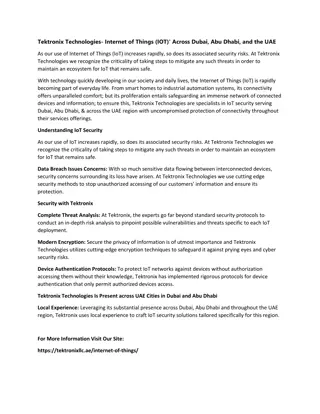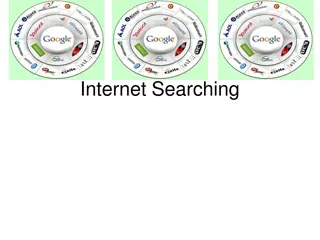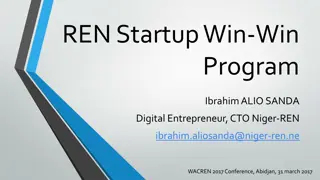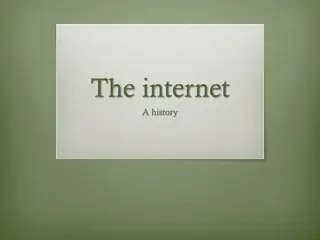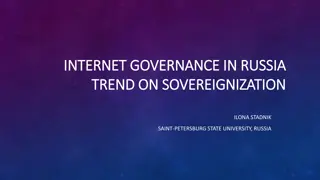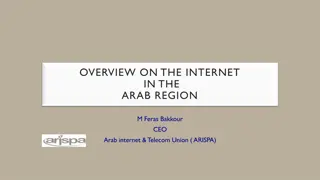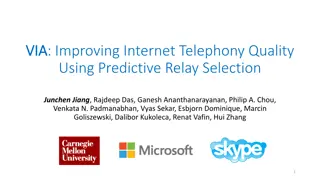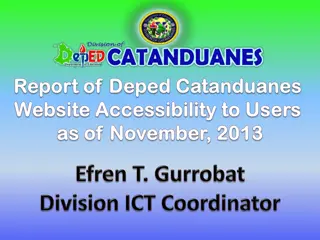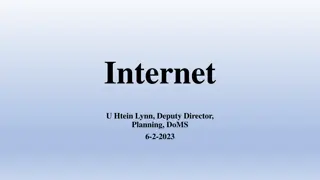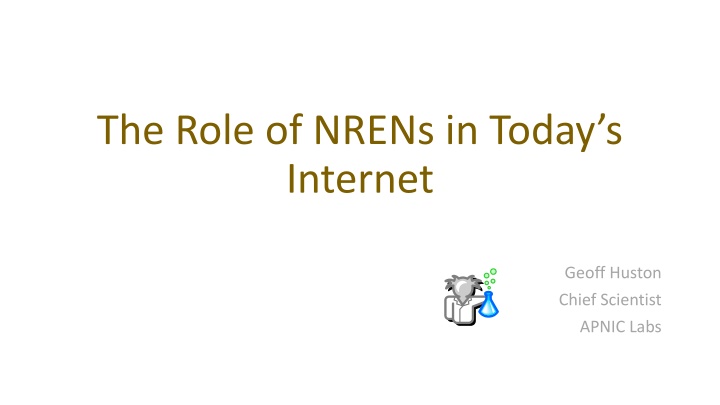
The Role of NRENs in Today’s Internet
Explore the significant role of National Research and Education Networks (NRENs) in advancing the modern Internet landscape, as discussed by Geoff Huston, Chief Scientist at APNIC Labs. Gain insights into the pivotal functions, challenges, and future prospects of NRENs in shaping the digital connectivity sphere.
Download Presentation

Please find below an Image/Link to download the presentation.
The content on the website is provided AS IS for your information and personal use only. It may not be sold, licensed, or shared on other websites without obtaining consent from the author. If you encounter any issues during the download, it is possible that the publisher has removed the file from their server.
You are allowed to download the files provided on this website for personal or commercial use, subject to the condition that they are used lawfully. All files are the property of their respective owners.
The content on the website is provided AS IS for your information and personal use only. It may not be sold, licensed, or shared on other websites without obtaining consent from the author.
E N D
Presentation Transcript
The Role of NRENs in Todays Internet Geoff Huston Chief Scientist APNIC Labs
I have two stories today: A quick review of the NREN history Some thoughts about Internet technology and its evolution And then we ll try to stitch them together!
My Background I took up a position in the Australian University sector at the start of 1989 to set up a national academic and research computer network By set up I mean design, build, manage, cajole, sell, persuade and do whatever was necessary to get it done! Some 5 years later I was sold, along with the entire national network and its customers to the then dominant domestic telco, Telstra I spent the next decade pushing within Telstra to set up a national consumer and enterprise internet services and re-position the Internet from an overlay application to a basic component of telco infrastructure For the past 15 years I ve been the Chief Scientist at APNIC, watching the telcos and NRENs evolve further
The NSFNET (the NREN Poster Child) The NSFNET was a runaway success Originally intended as a feeder platform for the US supercomputer effort, it gathered its own momentum within a couple of years It is extremely rare for just $40M of research funding over just 6 years to generate such a massive return of trillions of dollars of wealth to the US national economy in subsequent years! Everyone wanted to emulate some small part of this outstanding success - NRENs appeared in many countries Australia s path in NRENs was pretty typical of the NREN evolution
AARNet in the early 90s Australia started on the NREN path in 1989, initially prompted by US research funding agencies Australian Universities and research institutions were unused to working in concert on a single project up until that time The network was constructed to provide the entire sector with communications services that were otherwise unobtainable at the time If the sector wanted to use a national X.25 service network it could buy it from the telco But if it wanted to use anything else it had to build its own So it did It started as a multi-protocol network, modelled on Nordunet, but quickly shifted to IP only As it turned out the sector s technology needs were not far removed from enterprise and public sector needs The true value proposition of IP was to escape from vendor-based communications solutions Demand for IP access blossomed from many other sectors
AARNet in the mid 90s The Academic and Research Network was having trouble sticking to a limited A&R mission and quickly become a massive service network No other internet service was available The research sector could use commercial services income to defray the costs of the network A larger platform had access to higher capacity and lower unit costs of carriage services AARNet did everything: transit, access, wholesale, DNS, file stores, email relays At its peak AARNet had 650 ISPs as retail customers of AARNet s wholesale service
AARNet in the mid 90s But AARNet s rapid growth meant that: it quickly became too big to be a customer of any carriage provider The sector was unwilling to borrow capital to make large scale infrastructure investments, so the network continued to be a cash flow business without capital assets The network was owned and managed by the academic sector, not drawn from the comms sector, so decision making was often slow and fraught with angst over uncertainties It was big enough to stifle competitive offerings, so it was now in the way of conventional ISP enterprises It had out-performed its original objectives and it was time to let it go!
The Commercial Internet The sector sold AARNet s customers to Telstra in 1995 In many ways it was a forced decision AARNet was finding it hard to be a national ISP and an NREN at the same time, while the telco was finding it hard to enter the ISP market while AARNet existed If AARNet was a collective effort to provide a service that was otherwise unavailable then the rationale for this disappeared with the sale Internet access was now a commercial product The universities regrouped to become a sector-wide purchasing cartel
Early Naughties: Boom and Bust The Great Internet Bust of 2001 2003 created a collection of distressed infrastructure assets that could be picked up for cents in the dollar AARNet was no exception when it picked up fibre assets at firesale prices to form a national fibre backbone At this point AARNet transformed from being a constantly frustrated customer to become an infrastructure operator once again But this time it was not implementing a unique service, but attempting to operate a conventional IP carriage service at a competitive price point
2010s Role Erosion Today s Internet is a content delivery platform, not a connectivity fabric The role of NRENs as unique providers of very high capacity connectivity was falling out of step with the sector s requirements So the NRENs changed gear and concentrated on a role as a platform for specialized applications and services which strongly resembled a solution looking for a problem!
2020 - Wither NRENs? It s not looking good! NRENs are not a critical and unique provider for specialised networking services any more Most of the component technologies are now available in the market There is more innovation in high speed equity trading networks than can be found in most NRENS today! NRENs don t lead the way in content delivery services Like the telcos of 40 years ago, NRENs are now caught up in established service delivery and are unwilling to take on the risks and disruption of dramatic innovation As a purchasing cartel they lack volume and find it increasingly hard to be cost competitive for the bulk of their client service portfolio
2020 - Wither NRENs? It s not looking good! NRENs are not a critical and unique provider for specialised networking services any more Most of the component technologies are now available in the market There is more innovation in high speed equity trading networks than can be found in most NRENS today! NRENs don t lead the way in content delivery services Like the telcos of 40 years ago, NRENs are now caught up in established service delivery and are unwilling to take on the risks and disruption of dramatic innovation As a purchasing cartel they lack volume and find it increasingly hard to be cost competitive for the bulk of their client service portfolio
Economics of Innovation Adoption pressure Incumbent Resistance Incumbent Replacement Market Destruction! 2x 4x 16x 64x 32x Unit Cost Reduction
Examples of Transformations Circuits to Packets 100x unit cost reduction in network service The change was large enough to destroy the existing telco market Hardware to Cloudware 2x 4x unit cost reduction Moderate pace of change that has allowed some incumbents to ride the change while others have had a harder time Domain Name Certificates From luxury good to free commodity resulting in market destruction
Tougher Examples IPv6 No marginal unit cost improvement Incumbents feel no major pressure to adopt 25 year transition with no end in sight DNSSEC Increased unit cost without clear incremental benefits Another protracted transition with no end in sight
Whats going on? Why was IPv4 a runaway success while IPv6 has been a slow motion train wreck of prevarication and delay? Why is security a market failure? Is Google now so entrenched that it is beyond all but the most disruptive of competitive technology pressures?
What drives change? Fear and Greed! Incumbency breeds risk aversion and increasing inertia This breeds increasing barriers to market entry by competitive actors This means that the cost of risk rises Venture capital funds increasingly uninterested in small cap ventures its either billions or nothing, because underfunded exercises in disruptive competition are increasingly likely to fail
What do NRENS have to do with technology evolution? If NRENs aspire only to be mini telco s then the answer is nothing! But if that s all that the NREN is trying to achieve then maybe the NREN has failed already as a platform for applied research into advanced network technology NRENs should be focussed at the leading edge of innovation and change in networking technologies
What should NRENs do? NRENs should be confident enough in themselves to operate with a much higher risk appetite for innovation NRENs should be able crystallise what makes communications technologies both disruptive and transformative NRENs should be focussed on research into networking, not merely a networking platform for researchers
What should NRENs do? NRENs should be confident enough in themselves to operate with a much higher risk appetite for innovation NRENs should be able crystallise what makes communications technologies both disruptive and transformative NRENs should be focussed on research into networking, not merely a networking platform for researchers
Drilling down So far this is all rather abstract
Drilling down So far this is all rather abstract Let s take a more detailed look at some specific technologies
Drilling down This is all rather abstract Lets take a more detailed look at some specific technologies
IP was just so simple Version IHL Total Length Type of Service Identification Flags Fragment Offset Time To Live Protocol Header Checksum Source Address Destination Address Options Padding Hop-by-Hop stateless forwarding Datagram transmission End-To-End data integrity Decoupled resource management, topology management
What dont we understand Multicast
What dont we understand Multicast MPLS
What dont we understand Multicast MPLS Congestion Control
What dont we understand Multicast Buffering and Queues MPLS Congestion Control
What dont we understand Multicast Buffering and Queues MPLS Congestion Control QoS
What dont we understand Multicast Buffering and Queues MPLS Congestion Control Consistent Speed QoS
What dont we understand Multicast Buffering and Queues High Speed MPLS Congestion Control Consistent Speed QoS
What dont we understand Multicast Buffering and Queues Ultra High Speed High Speed Consistent Speed MPLS Congestion Control QoS
What dont we understand Multicast Delay Buffering and Queues Ultra High Speed High Speed Consistent Speed MPLS Congestion Control QoS
What dont we understand Multicast Delay Buffering and Queues Ultra High Speed High Speed Consistent Speed MPLS Congestion Control QoS Load Management
What dont we understand Multicast Delay Buffering and Queues Ultra High Speed High Speed Consistent Speed MPLSRouting QoS Load Management Congestion Control
What dont we understand Multicast Identity and location overloading Delay Buffering and Queues Ultra High Speed High Speed Consistent Speed MPLS Routing QoS Congestion Control Load Management
What dont we understand Identity and location overloading Multicast Packet quantization and fragmentation Delay Buffering and Queues Ultra High Speed High Speed Consistent Speed MPLS Routing QoS Congestion Control Load Management
What dont we understand Identity and location overloading Multicast Packet quantization and fragmentation Delay IPv6 Buffering and Queues Ultra High Speed High Speed Consistent Speed MPLS Routing QoS Congestion Control Load Management
What dont we understand Identity and location overloading Multicast Packet quantization and fragmentation Delay IPv6 Buffering and Queues Tunnels Ultra High Speed High Speed Consistent Speed MPLS Routing QoS Congestion Control Load Management
What dont we understand Identity and location overloading Multicast Packet quantization and fragmentation Delay IPv6 Mobility Buffering and Queues Tunnels Ultra High Speed High Speed Consistent Speed MPLS Routing QoS Congestion Control Load Management
What dont we understand Identity and location overloading Multicast Packet quantization and fragmentation Jitter Tunnels Mobility Buffering and Queues Delay IPv6 Ultra High Speed High Speed Consistent Speed MPLS Routing QoS Congestion Control Load Management
What dont we understand Identity and location overloading Multicast Packet quantization and fragmentation Delay Wireless IPv6 Jitter Mobility Buffering and Queues Tunnels Ultra High Speed High Speed Consistent Speed MPLS Routing QoS Congestion Control Load Management
What dont we understand Identity and location overloading Multicast Packet quantization and fragmentation Delay IPv6 Mobility Buffering and Queues Wireless security Jitter Tunnels Ultra High Speed High Speed Consistent Speed MPLS Routing QoS Congestion Control Load Management
What dont we understand Network Management Identity and location overloading Multicast Packet quantization and fragmentation Delay IPv6 Mobility Buffering and Queues Wireless security Jitter Tunnels Ultra High Speed High Speed Consistent Speed MPLS Routing QoS Congestion Control Load Management



